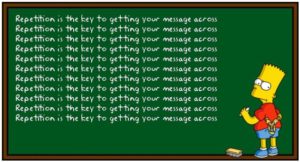Repetition in Marketing and it’s importance
FULL TRANSCRIPT BELOW:
Daniel Whittington: Welcome to American Small Business Institute. I’m again here with Mr. Stephen Semple. And today, we’re gonna talk about repetition in marketing. And this is coming from a digital-first perspective, right? I’m gonna warn you; he’s saying things. Scary things for digital-only people. So what were you talking about, Stephen?
Stephen Semple: Well, one of the challenges that we have is, you know, people will look at … they’ll be looking at a campaign and then they’ll see, oh, good, oh, look, our website is doing so much better. It’s because of the website, it’s because of the changes we made to our website.
Daniel Whittington: Right.
Stephen Semple: And it may have nothing to do with that. It may have to do with all of the other things that are going on. Like, somebody comes here and they take magical roles-
Daniel Whittington: Right.
Stephen Semple: One of the first things they learn is the power of repetition.
Daniel Whittington: Right.
Stephen Semple: And that through repetition is one of the ways in which we move things from short-term memory into long-term memory. Right?
Daniel Whittington: Right.
Stephen Semple: So repetition is important. But that also means all of the other things that somebody sees before they come to your website becomes important.
Daniel Whittington: Right.
Stephen Semple: And it may actually be a bunch of those other things, or all these things in combination that’s actually what’s working, not that, wow, we’ve all the sudden got this awesome website.
Daniel Whittington: Right. So, does that mean that you need to be everywhere all the time to increase repetition?
Stephen Semple: Not necessarily. So lemme give you an example. So here’s a direct mail campaign. So Canada Post, I’m Canadian, that’s our national postal service.
Daniel Whittington: It’s okay.
Stephen Semple: Yeah, I know. You’ll forgive me at some point. So our national postal service in conjunction with one of the banks ran a test. They created this 12 piece mailing.
Daniel Whittington: Right.
Stephen Semple: And they mailed it out. Mailed out one, mailed out two…
Daniel Whittington: Like a 12 pager?
Stephen Semple: No, no, it was 12 separate pieces.
Daniel Whittington: Okay.
Stephen Semple: So they mailed one-
Daniel Whittington: Oh.
Stephen Semple: And then they mailed you another one a couple weeks later-
Daniel Whittington: Okay.
Stephen Semple: Another one a couple weeks later, 12 pieces. And then they looked at what was the most effective one. The most effective one was the third one. So you can sit there and say, “Oh, well then this is the message that works best, right?”
Daniel Whittington: Let’s redesign all the things to match the third one.
Stephen Semple: Right. Well, what they did was, they said, well, okay, let’s do this again, but we’re going to shuffle the order. And guess which one was the most effective one?
Daniel Whittington: Oh.
Stephen Semple: The third one.
Daniel Whittington: Yeah.

Stephen Semple: Which was now a different one than it was last time. And then they did it again, and what was the most effective one? The third one.
Daniel Whittington: So it turns out we don’t need four through 12.
Stephen Semple: Maybe not. Maybe not. But the point is is that if you think about … so if I add … if I’m running AdWords-
Daniel Whittington: Right.
Stephen Semple: On websites and I add a radio campaign and I get a lift to my website, was it the website or is the fact that now I’m hitting them again through another media-
Daniel Whittington: Right.
Stephen Semple: Through another means, through the repetition of radio.
Daniel Whittington: Yeah, that’s true. Because I remember … so, you know, on Instagram, you now have inserted advertising-
Stephen Semple: Right.
Daniel Whittington: As you’re flying through, right? And every once in a while I’ll see something and go, “Oh, that looks kind of cool.” But on principle, I’m just not going to click on it.
Stephen Semple: Right.
Daniel Whittington: And then later someone will tell me about his same business, and they’re like, oh, have you heard about this thing? And they make these shoes and they’re really cool. And I’m like, where did hear about that? Oh, it was in the Instagram feed. And then I’ll go back scrolling through my Instagram feed trying to find the ad for those shoes so I can click on it from there because I can’t remember the name from either of them.
Stephen Semple: Right.
Daniel Whittington: But I know I’ll recognize it when I see the picture.
Stephen Semple: Right. Oh, yeah-
Daniel Whittington: But if someone reading that is going to be like, oh, our Instagram ad was the most successful of our campaign-
Stephen Semple: Was the part that drove it-
Daniel Whittington: Yeah.
Stephen Semple: But it isn’t. It’s all these other things that go on. Or, you know, this is one of the reasons remarketing works well.
Daniel Whittington: Right.
Stephen Semple: So why does remarketing work well? Because the person comes to my website once and what do I do is I hit them with some repetition-
Daniel Whittington: Right.
Stephen Semple: And get them, you know, remembering me. And, you know, so, all of these … so the problem is, the challenge with all these things, especially when you factor in repetition as part of the key is it can be very hard to detangle all of these pieces because the real answer is, why’d the person remember you?
Daniel Whittington: Yeah.
Stephen Semple: Probably all the above.
Daniel Whittington: All the … yeah. Which one of these eight things worked? The answer is yes.
Stephen Semple: Yes. Often it is.
Daniel Whittington: Thank you, sir. I appreciate it.
Stephen Semple: All right.
Daniel Whittington: We’ll see you guys next week.